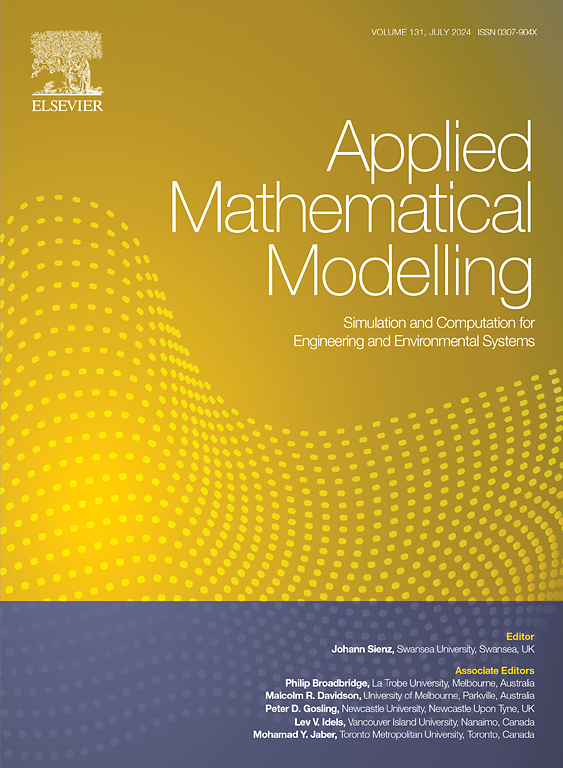Twistor-based integrated double hyperbolic sliding mode control for time-varying quadrotor UAV systems
IF 4.4
2区 工程技术
Q1 ENGINEERING, MULTIDISCIPLINARY
引用次数: 0
Abstract
This study pioneers the application of the twistor framework to address pose-coupled disturbances in UAVs with time-varying payloads. The twistor-based time-varying UAV dynamics concurrently describes translational and rotational dynamics, eliminating the need for algebraic transformation operations inherent in decoupled approaches while avoiding the parameter redundancy and normalization constraint of dual quaternion. Although twistor resolves fundamental dynamic limitations of conventional approach, complex disturbances from the time-varying payload require controllers with enhanced robustness and efficiency—a challenge unmet by existing twistor-based framework. To tackle pose-coupled disturbances within this framework, a double hyperbolic sliding mode controller (DH-SMC) featuring a novel double hyperbolic reaching law is proposed in this study. Results from numerical simulations and hard ware in the loop (HIL) experiments demonstrate that the proposed DH-SMC significantly outperforms constant-velocity SMC (CV-SMC), achieving a 29.8% reduction in energy consumption, 15.1% faster convergence, and a 70.3% decrease in maximum steady-state position error, confirming its superior robustness and real-time capability.
时变四旋翼无人机系统的综合双双曲滑模控制
该研究率先应用扭转框架来解决具有时变有效载荷的无人机中的姿态耦合干扰。基于扭量的时变无人机动力学同时描述了平移和旋转动力学,消除了解耦方法固有的代数变换操作,同时避免了对偶四元数的参数冗余和归一化约束。虽然twistor解决了传统方法的基本动态限制,但时变载荷的复杂干扰要求控制器具有增强的鲁棒性和效率,这是现有基于twistor的框架无法满足的挑战。为了解决该框架内的位姿耦合干扰,本文提出了一种具有新颖的双双曲趋近律的双双曲滑模控制器(DH-SMC)。数值模拟和硬件在环(HIL)实验结果表明,所提出的h -SMC明显优于恒速SMC (CV-SMC),能耗降低29.8%,收敛速度提高15.1%,最大稳态位置误差降低70.3%,证实了其优越的鲁棒性和实时性。
本文章由计算机程序翻译,如有差异,请以英文原文为准。
求助全文
约1分钟内获得全文
求助全文
来源期刊

Applied Mathematical Modelling
数学-工程:综合
CiteScore
9.80
自引率
8.00%
发文量
508
审稿时长
43 days
期刊介绍:
Applied Mathematical Modelling focuses on research related to the mathematical modelling of engineering and environmental processes, manufacturing, and industrial systems. A significant emerging area of research activity involves multiphysics processes, and contributions in this area are particularly encouraged.
This influential publication covers a wide spectrum of subjects including heat transfer, fluid mechanics, CFD, and transport phenomena; solid mechanics and mechanics of metals; electromagnets and MHD; reliability modelling and system optimization; finite volume, finite element, and boundary element procedures; modelling of inventory, industrial, manufacturing and logistics systems for viable decision making; civil engineering systems and structures; mineral and energy resources; relevant software engineering issues associated with CAD and CAE; and materials and metallurgical engineering.
Applied Mathematical Modelling is primarily interested in papers developing increased insights into real-world problems through novel mathematical modelling, novel applications or a combination of these. Papers employing existing numerical techniques must demonstrate sufficient novelty in the solution of practical problems. Papers on fuzzy logic in decision-making or purely financial mathematics are normally not considered. Research on fractional differential equations, bifurcation, and numerical methods needs to include practical examples. Population dynamics must solve realistic scenarios. Papers in the area of logistics and business modelling should demonstrate meaningful managerial insight. Submissions with no real-world application will not be considered.
 求助内容:
求助内容: 应助结果提醒方式:
应助结果提醒方式:


